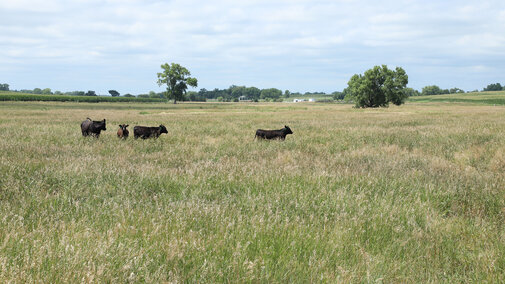The Right Stocking Rate
Stocking pastures with the right number of animals is one of the cornerstones of proper grazing management. It’s tempting to take the easy route and keep using the same rate year after year. After all, if it’s not broke, why fix it? But over time, could this approach do more harm than good?
While we might be aware of the importance of proper stocking, we may fail to properly adjust rates to match the current reality of our operation. Proper stocking depends on two factors — animal intake and pasture productivity. Changes to either of these factors — even if they take place so slowly we don’t notice — can throw the balance off.
Production can change for the worse or better. Improving management practices like resting pastures, fertilization or improving distribution may have actually improved production and led to understocking over time.
On the flip side, prolonged overgrazing or encroachment of invasive species like leafy spurge or cedar trees can eat away production. It is estimated that a single cedar tree with an 8-foot diameter could reduce forage production by three pounds. If you had a density of 200 trees per acre, that would translate into nearly a 1/3 loss in forage production because of the effects of area coverage, moisture use and shading.
When we look at the demand side, animal size has a direct correlation with consumption. A 1,400 lb cow will naturally need to consume more than a 1,200 lb animal. While this difference may seem small (5.2 lb of air-dried forage per day), this quickly adds up across the herd and over the grazing season. Add on top of that increased demand from high milk and production genetics we’ve selected for over time and it’s safe to say the average cow today consumes more forage than its counterpart 20 years ago.
Haylage and Baleage Equipment and Preparations
Both haylage and baleage use the process of fermentation or ensiling to preserve forages, and require proper harvesting and storage techniques. Do you have equipment to do the job right?
Baleage can be confused with traditional dry hay because it is still a square or round bale in appearance. Inside, it’s hay that is higher moisture than dry hay so it is wrapped or otherwise sealed in plastic for storage. Baleage can be fermented as individual bales or in a tube/inline. Already we can see that added or changes to equipment will be needed to utilize this high quality preservation technique. Haylage is wilted hay that is chopped and put into silos, bunkers or bags.
Haylage is similar to corn silage from an equipment needs standpoint. For baleage, the equipment changes are not too significant but need to be considered.A different baler might be needed for some producers. Wrapping equipment is cheaper than a silage chopper, but handling the bales requires different equipment than the classic bale spear or grapple, unless the inline wrapping machine does all the wrapping. When picking up bales to take to the tube wrapper, some suggest using a double spear because it will reduce the large air pocket produced by the weight of the bale on just a single spear.
Plastic maintenance is needed if holes occur by the environment or animals and plastic requires disposal after use.
Make sure before the season starts, the plastic and equipment is ready to go or lined up to be rented.
Summer Annual Grass Control
The use of trade names or products does not indicate the promotion of products, these are strictly used for educational purposes. Information has been adapted from the 2021 Guide for Weed, Disease, and Insect Management in Nebraska.
Summer annual grasses are tough weeds to deal with, especially in mixed perennial systems like pasture or hay fields. Species like foxtail, sandbur and crabgrass begin growth late, grow fast and produce seed. In straight alfalfa stands, several herbicide options are available, but in alfalfa grass mixes, options are limited.
In mixed alfalfa/grass systems, selecting one grass species from another for control is difficult. Cultural practices are often our best bet. However, established perennials can handle some pressure from pre-emergence herbicides, though a slight yield hit can occur. For these products to be successful, application timing is crucial. Treat too early and we lose residual coverage, allowing late germinating seedlings to grow. Too late and already growing older plants may be able to survive.
Our first step — find the right pre-emergent product. To clarify, we mean pre-weed emergence, not perennial grasses or alfalfa. For alfalfa/grass mixes, Prowl H20® fits the bill.
Although it may be tempting to start applying right away, we need to wait. Just like our seeded crops, these weeds need a certain sustained soil temperature to begin germination. For crabgrass, soil temps need to be sustained at 55°F, for foxtail 60°F, and for sandbur its 65°F. Start monitoring soil temperatures and when the appropriate threshold for the species you want to control is crossed, we can get ready to apply. Make sure to follow the appropriate label restrictions of crop stage, pre-harvest intervals, grazing and maximum application amounts listed.
Summer annual grasses in forage crops are not the easiest weeds to deal with, but with the right product, a bit of patience and proper timing, it doesn’t have to be a problem we can’t control.

